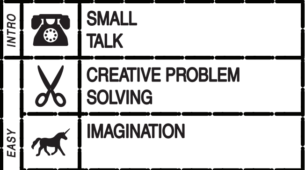Spyfall was created by Alexandr Ushan and published by Hobby World in 2014. Spyfall was designed for 3-8 players and is listed as being for ages 13+. While players younger than this would likely be able to play Spyfall successfully, older players are likely better able to tread the balance between revealing and concealing information.
At its core, Spyfall is a game that creates fun in two main ways: this balancing act and the collective world building that comes with it.
Spyfall is first and foremost a game that deals in information and balancing how it is meted out to players. Non-spies must reveal enough information to convince their fellow non-spies that they do, in fact, know where they are, while at the same time, being vague enough so that the spy won’t be able to “fit in” or otherwise guess the location. For the spy, it’s a fine line between answering in an explicit enough way to not incur suspicion, while not saying too much that it may reveal their own lack of information. This is where the “challenge” type of fun comes in—how are we, as players, going to craft acceptable questions and responses? And on the flip side, how are we going to analyze and scrutinize them? The non-spies must carefully consider the other players’ responses in their attempts to root out the spy; the spy must carefully consider the other players’ responses in order to gather as much information for themselves as possible. For example, when playing, we all voted our friend Eric to be the spy because his answers were often extremely vague and would change based on our immediate reactions. However, he was, in fact, not the spy. He explained that he answered the way he did in order to try to prevent the spy from guessing the location. It becomes clear, then, that players not only have to balance information given, but they have to do it in context of the other players’ strategy and play-style. Eric, in a group of non-spies who were much more direct and more focused on outing the spy, ended up drawing suspicion to himself.
This example also shows a bit of how the balancing act also invokes “fellowship”-style fun. Non-spies must be able to recognize each other, cooperate, and trust that they all know the common location. In some sense, Spyfall also creates an in-group (of the presumed non-spies) and an out-group (the spy), which may tap into basic human drive to identify with a social group and work together against some common enemy or outside force. Returning to said example, while Megan (the real spy) had also said some questionable things about our location (i.e. that there were 7000 military bases in the U.S.). At this point, however, majority opinion had solidified around Eric being the “outsider”, which led to us having perhaps too much fun vilifying him and picking apart his responses. Not only do players have to balance information, but also their own standing with the others.
Conversely, the spy, in trying to make sense of the non-spies’ responses, is arguably performing a kind of world-building. Each of the non-spies’ answers will almost always have something in common in order to signal that they know the location and are to be trusted—it is up to the spy to piece all this information together in a logical way and reverse-engineer the “world” that the others all belong to. Here it can be said that while the “magic circle” between game and real life can be drawn around all of the players (spy included), there is an “inner circle” of the non-spies of which the spy is trying to push the boundaries of. Additionally, the spy must also create a character for themselves—one that is a privy to the location and thus, part of the inner world—and answer based on what that character would say.
However, it does seem rather similar to other social deduction games, such as Mafia. One difference (and potential benefit) though is that Spyfall allows all its players to be active throughout the entire duration of the game. Unlike Mafia, which needs a narrator who is somewhat outside of the game and has people who die and thus no longer affect the game, as long as discussion is active, all the players of Spyfall can continue to participate.
While playing, though, we did have a couple ideas for modifying the game. Especially for larger groups, a longer discussion time proved to be more fun, as did not having a list of possible locations available to us. Having a longer discussion period made for some more fun and interesting questions, and allowed the spy more time to also try to figure out where the rest of the players were, which also offset the challenge of not having a list of locations to pick from.
Overall, Spyfall largely accomplishes its goals, even with its relatively simple premise. By invoking several types of fun through cleverly designed mechanics, it ends up being a worthwhile game to play.


